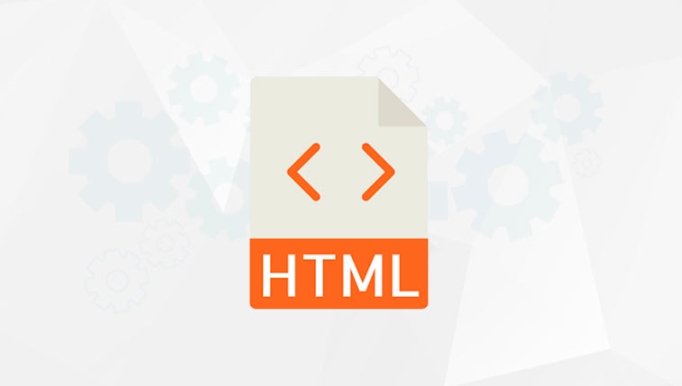There are two main ways to implement HTML5 lazy loading images: 1. Use the loading="lazy" property of the  tag, which is suitable for modern browsers without JS; 2. Use the Intersection Observer API to achieve more flexible control and compatibility with old browsers. When using loading="lazy", you should be careful not to apply to the first screen image, and it has three values: auto, lazy, and eager. Intersection Observer needs to store the real address through data-src and assign src when entering the viewport. At the same time, you should pay attention to setting fixed width and height, using placeholder maps, avoiding lazy loading of important images, and combining srcset and cache strategies to optimize experience and performance.
tag, which is suitable for modern browsers without JS; 2. Use the Intersection Observer API to achieve more flexible control and compatibility with old browsers. When using loading="lazy", you should be careful not to apply to the first screen image, and it has three values: auto, lazy, and eager. Intersection Observer needs to store the real address through data-src and assign src when entering the viewport. At the same time, you should pay attention to setting fixed width and height, using placeholder maps, avoiding lazy loading of important images, and combining srcset and cache strategies to optimize experience and performance.

Lazy loading of images has actually become very simple in HTML5, and it mainly relies on the loading attribute of the <img src="/static/imghw/default1.png" data-src="https://img.php.cn/upload/article/000/000/000/175233613755932.jpeg" class="lazy" alt="How to lazy load images in HTML5?" > tag. You only need to add a property and the browser can automatically delay loading pictures that are not in the viewport.

Using loading="lazy" is the most direct way
HTML5 natively supports lazy loading is to add loading="lazy" attribute to the <img src="/static/imghw/default1.png" data-src="https://img.php.cn/upload/article/000/000/000/175233613858057.jpeg" class="lazy" alt="How to lazy load images in HTML5?" > tag. In this way, the browser will wait until the image is close to the user's visual area before starting to load.
For example:

<img src="/static/imghw/default1.png" data-src="image.jpg" class="lazy" alt="Descriptive text" loading="lazy">
This method is suitable for most modern browsers (Chrome, Edge, Firefox, etc.) and does not require additional JS or complicated configurations.
A few points to note:

- It is not recommended to use lazy loading for the first screen image, as it may affect the loading speed and SEO;
-
loadinghas three values:auto,lazyandeager, the default isauto, that is, the browser decides whether to lazy load; - If you want to be compatible with old browsers (such as IE), you have to use JavaScript's Intersection Observer to implement it.
Work with Intersection Observer to achieve more flexible control
If you need more control or want to be compatible with some browsers that do not support loading="lazy" , you can use the Intersection Observer API.
The basic idea is to first let the image occupy a place, and then assign the real image address to src attribute when it enters the visual area.
The sample code is as follows:
<img class="lazy-img lazy" src="/static/imghw/default1.png" data-src="image.jpg" data- alt="descriptive text">
Then write a JS to listen to whether it enters the viewport:
const images = document.querySelectorAll('.lazy-img');
const observer = new IntersectionObserver((entries) => {
entries.forEach(entry => {
if (entry.isIntersecting) {
const img = entry.target;
img.src = img.dataset.src;
observer.unobserve(img);
}
});
});
images.forEach(img => observer.observe(img));This method is suitable for projects that require animation, load optimization, or high compatibility requirements.
You should also pay attention to user experience if you lazy load pictures
Although lazy loading can improve performance, if it is not processed properly, users may see blank areas for too long, which will affect the experience.
you can:
- Set a fixed width and height for the picture to prevent layout jitter;
- Displays the placeholder map or skeleton screen before loading;
- For important pictures (such as carousels), do not use lazy loading;
- Use
srcsetandsizesat the same time, allowing the browser to select the appropriate image size according to the device.
In addition, if you are loading pictures from the server, make sure to set up appropriate caching policies and response headers to avoid repeated requests affecting loading speed.
Basically that's it. The native lazy loading function of HTML5 is already very practical, and can achieve more granular control with JS. The key is to choose the right method according to the project needs. Don’t use lazy loading all of them, and don’t use them at all. The key is to balance the performance and experience.
The above is the detailed content of How to lazy load images in HTML5?. For more information, please follow other related articles on the PHP Chinese website!

Hot AI Tools

Undress AI Tool
Undress images for free

Undresser.AI Undress
AI-powered app for creating realistic nude photos

AI Clothes Remover
Online AI tool for removing clothes from photos.

Clothoff.io
AI clothes remover

Video Face Swap
Swap faces in any video effortlessly with our completely free AI face swap tool!

Hot Article

Hot Tools

Notepad++7.3.1
Easy-to-use and free code editor

SublimeText3 Chinese version
Chinese version, very easy to use

Zend Studio 13.0.1
Powerful PHP integrated development environment

Dreamweaver CS6
Visual web development tools

SublimeText3 Mac version
God-level code editing software (SublimeText3)

Hot Topics
 Audio and Video: HTML5 VS Youtube Embedding
Jun 19, 2025 am 12:51 AM
Audio and Video: HTML5 VS Youtube Embedding
Jun 19, 2025 am 12:51 AM
HTML5isbetterforcontrolandcustomization,whileYouTubeisbetterforeaseandperformance.1)HTML5allowsfortailoreduserexperiencesbutrequiresmanagingcodecsandcompatibility.2)YouTubeofferssimpleembeddingwithoptimizedperformancebutlimitscontroloverappearanceand
 Audio and Video: can i record it?
Jun 14, 2025 am 12:15 AM
Audio and Video: can i record it?
Jun 14, 2025 am 12:15 AM
Yes,youcanrecordaudioandvideo.Here'show:1)Foraudio,useasoundcheckscripttofindthequietestspotandtestlevels.2)Forvideo,useOpenCVtomonitorbrightnessandadjustlighting.3)Torecordbothsimultaneously,usethreadinginPythonforsynchronization,oroptforuser-friend
 Adding drag and drop functionality using the HTML5 Drag and Drop API.
Jul 05, 2025 am 02:43 AM
Adding drag and drop functionality using the HTML5 Drag and Drop API.
Jul 05, 2025 am 02:43 AM
The way to add drag and drop functionality to a web page is to use HTML5's DragandDrop API, which is natively supported without additional libraries. The specific steps are as follows: 1. Set the element draggable="true" to enable drag; 2. Listen to dragstart, dragover, drop and dragend events; 3. Set data in dragstart, block default behavior in dragover, and handle logic in drop. In addition, element movement can be achieved through appendChild and file upload can be achieved through e.dataTransfer.files. Note: preventDefault must be called
 Adding Audio and Video to HTML: Best Practices and Examples
Jun 13, 2025 am 12:01 AM
Adding Audio and Video to HTML: Best Practices and Examples
Jun 13, 2025 am 12:01 AM
Use and elements to add audio and video to HTML. 1) Use elements to embed audio, make sure to include controls attributes and alternate text. 2) Use elements to embed video, set width and height attributes, and provide multiple video sources to ensure compatibility. 3) Add subtitles to improve accessibility. 4) Optimize performance through adaptive bit rate streaming and delayed loading. 5) Avoid automatic playback unless muted, ensuring user control and a clear interface.
 How can you animate an SVG with CSS?
Jun 30, 2025 am 02:06 AM
How can you animate an SVG with CSS?
Jun 30, 2025 am 02:06 AM
AnimatingSVGwithCSSispossibleusingkeyframesforbasicanimationsandtransitionsforinteractiveeffects.1.Use@keyframestodefineanimationstagesforpropertieslikescale,opacity,andcolor.2.ApplytheanimationtoSVGelementssuchas,,orviaCSSclasses.3.Forhoverorstate-b
 What is the purpose of the input type='range'?
Jun 23, 2025 am 12:17 AM
What is the purpose of the input type='range'?
Jun 23, 2025 am 12:17 AM
inputtype="range" is used to create a slider control, allowing the user to select a value from a predefined range. 1. It is mainly suitable for scenes where values ??need to be selected intuitively, such as adjusting volume, brightness or scoring systems; 2. The basic structure includes min, max and step attributes, which set the minimum value, maximum value and step size respectively; 3. This value can be obtained and used in real time through JavaScript to improve the interactive experience; 4. It is recommended to display the current value and pay attention to accessibility and browser compatibility issues when using it.
 HTML audio and video: Examples
Jun 19, 2025 am 12:54 AM
HTML audio and video: Examples
Jun 19, 2025 am 12:54 AM
Audio and video elements in HTML can improve the dynamics and user experience of web pages. 1. Embed audio files using elements and realize automatic and loop playback of background music through autoplay and loop properties. 2. Use elements to embed video files, set width and height and controls properties, and provide multiple formats to ensure browser compatibility.
 What is WebRTC and what are its main use cases?
Jun 24, 2025 am 12:47 AM
What is WebRTC and what are its main use cases?
Jun 24, 2025 am 12:47 AM
WebRTC is a free, open source technology that supports real-time communication between browsers and devices. It realizes audio and video capture, encoding and point-to-point transmission through built-in API, without plug-ins. Its working principle includes: 1. The browser captures audio and video input; 2. The data is encoded and transmitted directly to another browser through a security protocol; 3. The signaling server assists in the initial connection but does not participate in media transmission; 4. The connection is established to achieve low-latency direct communication. The main application scenarios are: 1. Video conferencing (such as GoogleMeet, Jitsi); 2. Customer service voice/video chat; 3. Online games and collaborative applications; 4. IoT and real-time monitoring. Its advantages are cross-platform compatibility, no download required, default encryption and low latency, suitable for point-to-point communication






